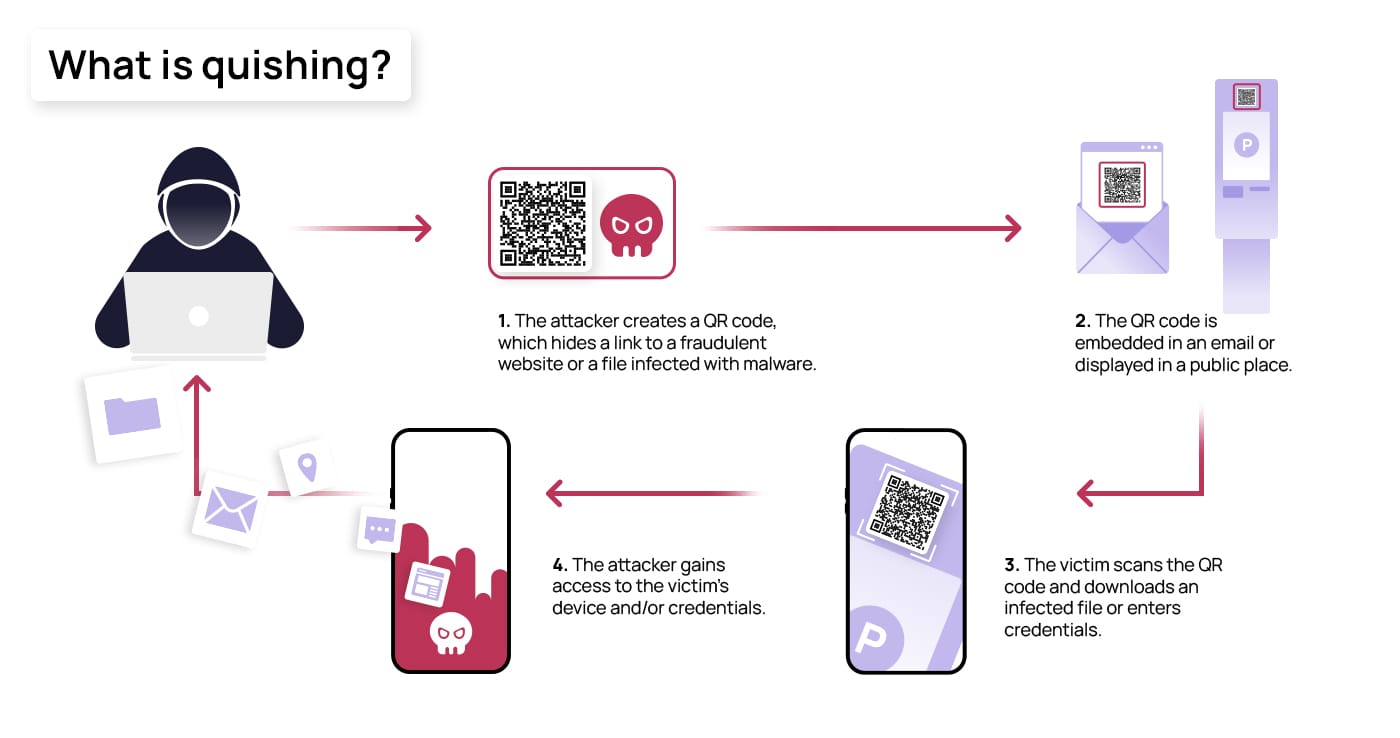Quishing
A new report by a cybersecurity firm reveals that hackers are constantly finding new ways to deploy QR codes in phishing campaigns.
- Quishing – It is a QR code phishing, a cybersecurity threat in which attackers use QR codes to redirect victims to malicious websites or prompt them to download harmful content.
Phishing is a common type of cyber-attack that targets individuals through email, text messages, phone calls, and other forms of communication.
|
Quick Response codes (QR codes)
|
- They are 2-dimensional barcodes that can be scanned easily with a camera or a code reader application.
- It have the capability to store information including URLs, product details, or contact information.
- Scanning technology allows smartphone cameras or code readers to easily and quickly access the website to which the URL points.
|
- Technique used – Conditional QR Code Routing Attacks.

- Working – The targeted person is tricked into scanning a QR code embedded with a uniform resource locator (URL).
- It redirects to the credential harvesting page, which results in the installation of a malware that steals sensitive information such as bank account details.
- Threat – The number of UPI frauds doubled from 15,000 cases in 2022 to 30,000 in 2023.
- Causes – Due to the widespread use of mobile phones and digital payment systems, coupled with poor cybersecurity practices.
- Challenges – The attack is incredibly personalised and targeted, by providing the legitimate company logo and using the correct name and user name.
- By changing dynamically depending on the target, this attack is scalable, as well.
- Guidance to prevent it – Implement security that automatically decodes QR codes embedded in emails and analyse the URLs for malicious content.
- Utilise security that rewrites the embedded QR code in the email body and replace it with a safe, re-written link.
- As always, if it is urgent or feels out of ordinary, do not scan the code QR Code.
Reference
The India Express| Increase in QR Code Phishing attacks
Malabar Pit Vipers
Researchers have taken up a detailed radio telemetry study of the Malabar Pit Vipers to understand their habitat and activity patterns and to find their antidote.
An antidote is a chemical substance that controls the effect of a poison.
- It is one of the type of 9 Pit Vipers.
- Scientific Name – Craspedocephalus malabaricus, (formerly Trimeresurus malabaricus).
- Family – Viperidae
- Nativity – Endemic to Western Ghats.
- Habitat – Tropical Evergreen Forests.
- Features – They are Nocturnal, arboreal and Ovoviviparous (give birth to live young).
- Triangular head much broader than the neck, heat sensing pits between eyes and nostrils.
- They have spots in various zigzag patterns across the body.
- They have variable colour, often green, brown, or yellow with patterns.
- They have heat-sensing pits to detect warm-blooded prey.

- Dimorphism – Males are generally smaller than females.
- Venom – Hemotoxic, causing pain and swelling, but rarely fatal to humans
- Conservation status
- Wildlife Protection Act, 1972 – Schedule-2
Malabar Pit Viper (MPV) is one among the 15 snakes for which medical supplies should be available as per the guidelines of the World Health Organization (WHO).
Reference
The New Indian Express| Malabar Pit Viper
Blaze Star
NASA predicts that the Blaze Star will become visible to the naked eye by September 2024.
- It is officially named as T Coronae Borealis (T CrB), is actually 2 stars binary system.
- Binary system
- A white dwarf – An Earth-sized remnant of a dead star with a mass comparable to that of our Sun.
- An ancient red giant – It is being stripped of hydrogen by the relentless gravitational pull of its hungry neighbour.
- Located in – The Constellation Corona Borealis, the "Northern Crown," between the constellations of Boötes and Hercules.
- It is 3,000 light-years away from our solar system.
- Magnitude - +10 (beyond naked-eye visibility) to magnitude +2 (visible).
T Coronae Borealis (T CrB) will be visible for the 1st time in 2024 since 1946 due to possible eruptions. It will be as bright as Polaris, the North Star, the 48th-brightest star in the night sky.
- Reason for eruption - The hydrogen from the red giant accretes on the surface of the white dwarf, building up of pressure and heat.
- Eventually, it triggers a thermonuclear explosion big enough to blast away that accreted material.
- This event appears to reoccur, on average, every 80 years
T Coronae Borealis (T CrB) have erupted previously in the years 1946 and 1866, with earlier documented observations dating back to 1787 and 1217.
- Significance – The Blaze Star is a rare example of a recurrent nova, which means "new star" in Latin.

Reference
Live science| Blaze star
Smart Meters
India's power distribution system remains inefficient, with state-owned businesses facing persistent struggles despite various financial aid schemes.
- Smart meter- Smart meters provide automated, accurate and real-time data on electricity consumption, reducing human errors associated with manual meter readings.
- Automation of meter reading and billing processes reduces operational costs.
- Digitising distribution- Smart meters are the first block in digitising power distribution.
- IntelliSmart- It is a joint venture of state-owned EESL and NIIF, and is a participant in smart meter tenders of states.
- Real-time data- It helps discoms collect real-time data on electricity usage and faults.
- Advantages- It helps to prevent electricity leakages and make billing efficient, reducing the aggregate technical and commercial (AT&C) losses of discoms.
- Revamped Distribution Sector Scheme (RDSS)
- Launched in- 2021
- Aims- To improve the discoms’ operations and finances.
- Objective- To improve the quality and reliability of power supply to consumers through a financially sustainable and operationally efficient Distribution Sector.
- Targets- The overall target is to install 250 million smart meters by 2025.
- Sector players- Adani Power, L&T, Tata Power and GMR.
Reference
Business Standard | Smart Meter
National Health Claim Exchange
The Health Ministry and the Insurance Regulatory and Development Authority of India (IRDAI) are jointly launching the National Health Claim Exchange (NHCX).
Health insurance contributes to around 29% of total general insurance premium income in India.
- Objective- NHCX will be a digital platform bringing together insurance companies, healthcare providers, and government insurance scheme administrators.
- It will facilitate the exchange of claims-related information among healthcare and insurance stakeholders.
- Aim- The exchange will serve as a gateway for exchanging claims-related information among various stakeholders in the healthcare and health insurance ecosystem.
- It also aimed at allowing patients to access quality healthcare swiftly and with reduced out-of-pocket expenditure.
- Implementation- The insurance industry will support this system by streamlining interactions between hospitals and insurers, creating a seamless, paperless, and secure contractual framework.
- Agency involved- Life insurance corporation (LIC) to play a key role in achieving ‘Insurance for All by 2047’
- Claims processing- It aims to improve efficiency and transparency in health claims processing, benefiting policyholders and patients.
- Insurance authorities have mandated that all cashless claims must be processed within three hours of receiving discharge authorization from the hospital.
- In-patient cases- In India, hospitalization cases are highest among individuals insured through private purchase (54.4 per 1,00,000 persons).
- Urban area-The government-funded scheme beneficiaries have the highest inpatient care cases (60.4 cases per 1,00,000 persons).
- Rural areas-The private insurance show substantially higher in-patient cases (73.5 cases per 1,00,000 persons).
- Challenges- Improving hospital-insurance company relationships.
- Addressing the issue of discharge delays, miscommunication between hospitals and insurers.
- Trust among policyholders relies on efficient service delivery.
- Digital Health Incentive Scheme- To promote digital health transactions and patient record digitization, the National Health Authority launched the Digital Health Incentive Scheme (DHIS) in January 2023.
Reference
The Hindu| National Health Claim Exchange

